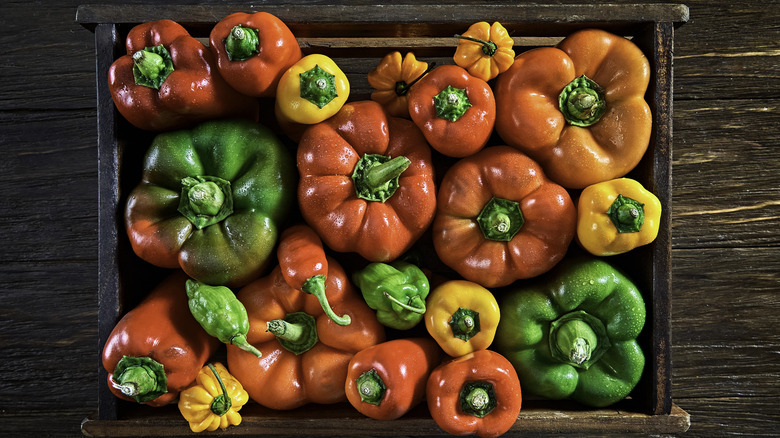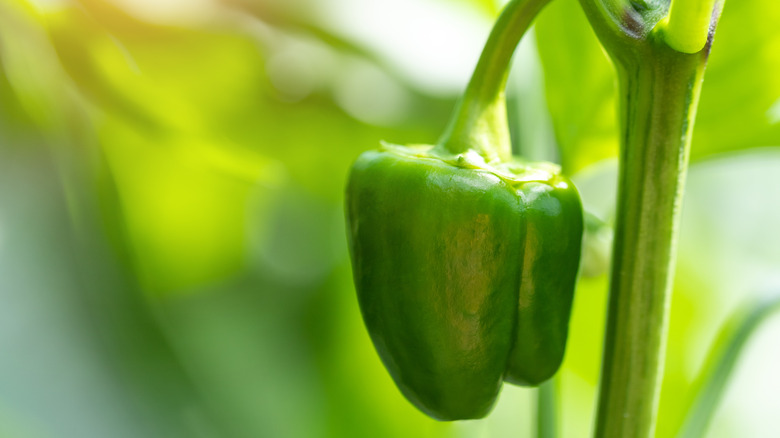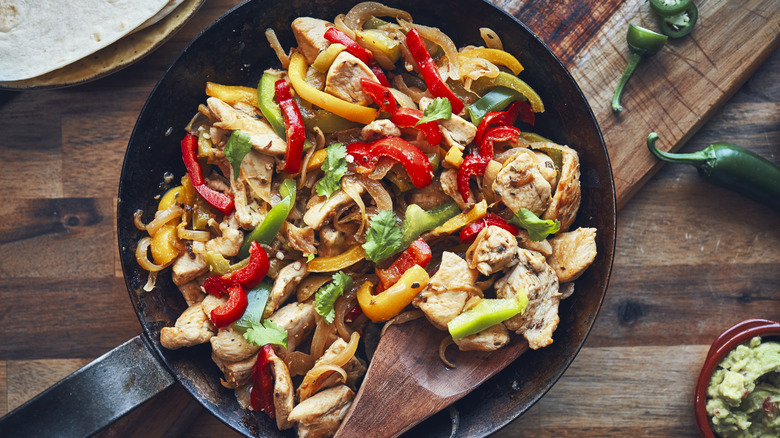Actually, A Bell Pepper's Color Affects How Long They Last In The Fridge
Compared to spicier pepper varieties, bell peppers are sweet, earthy, and crunchy when julienned, sauteed, or eaten fresh and dipped in homemade hummus. But have you ever brought a selection of colorful bell peppers home, stored them in the fridge, and wondered after a week why your green bell pepper is perfectly fine, while the red one sitting next to it has become shriveled, losing its signature crispness?
Here are some answers. The longer shelf life of green peppers is not just happenstance; bell peppers are the same variety of fruit picked from the vine at different levels of maturation, and green is picked first prior to ripening, according to researchers at Mississippi State University. Bell peppers may last one to two weeks in the fridge, with green bell peppers staying fresh the longest, sometimes even up to three weeks. Its yellow, orange, and red counterparts are all picked further along, when they are already ripe and markedly sweeter, and will start to show signs of spoilage a few days or even a week earlier.
While all bell peppers last longer when stored in the fridge in an airtight container, yellow, orange, and red varieties will lose their shine and crunchy nature quicker, and are best eaten within five days for optimal crispness. Green peppers will hold their crunchiness a bit longer. Of course, you can still enjoy bell peppers if they've started to dull or soften, as long they are free of mold or spoilage.
Green bell peppers are picked prior to ripening on the vine
Since green bell peppers are harvested before they've fully matured, they will last a few days, or up to a week longer than your other colorful bell peppers once you bring them home from the store. Once cut, most bell peppers should be eaten within a few days for best quality and to avoid a limp, mushy texture. Green bell peppers are often cheaper at the store due to their quicker harvest and less time on the vine. So, if affordability and shelf life are your main concerns, go with green bell peppers for your cooking and sauteing needs. But if you're looking for sweetness, you'll want to select other colorful varieties.
Just like other fruits, as they ripen on the vine, bell peppers become sweeter and the juicy flavor more pronounced. Green bell peppers turn yellow, then orange, and finally red as they are allowed to ripen on the vine. For this reason, red bell peppers are the sweetest and refreshingly juicy, while green bell peppers taste a little bitter and have a predominantly earthy flavor. In the middle, yellow and orange bell peppers are sweet, and even a bit fruity with notes of tangy acidity.
How to enjoy bell peppers within their shelf life
Once you know the differences between your colorful bell peppers, the opportunities are endless — just make sure to use them relatively quickly for freshness. Choose bell peppers that are firm to the touch and shiny, while avoiding those with noticeable blemishes and shriveling. Then chop up, deseed, and eat yellow, orange, and red varieties within a few days. Green bell pepper timing will be more forgiving.
Crunchy bell peppers are excellent tossed in salads or atop veggie sandwiches with cucumber and feta, for a bit of added crunch. Sweeter bell pepper varieties like yellow, orange, and red are also particularly tasty when charred on the grill, as the fire roasting accentuates their sweetness. Milder, grassy-tasting green bell peppers are best sauteed with onions as a flavorful base for a soup, stew, or tomato sauce to add a depth of vegetal notes.
If you can't eat your yellow, orange, or red bell peppers within a few days, don't sweat it; they will still be excellent for frying or baking in oil, where their crunch isn't as important. You can also extend bell peppers' longevity by giving them a quick pickle in white wine vinegar and salt, or by marinating them in zesty vinaigrette to complement their tangy sweetness. Plus, you can always chop up and freeze a colorful bell pepper medley to have on hand for all your weeknight stir-frying needs.


